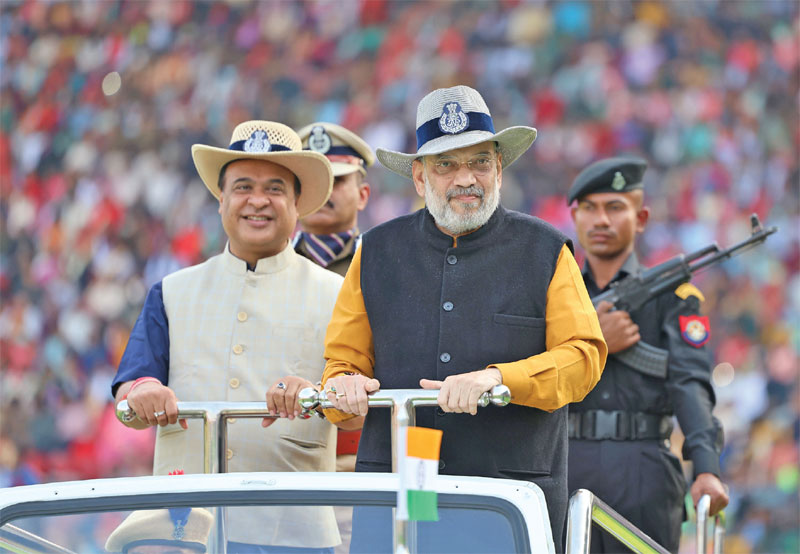Ending FMR, India to fence entire border with Myanmar
Subhashis Mittra
India has decided to fence the entire 1,643-kilometre-long India-Myanmar border, complete with a patrolling track alongside, bringing the curtain down on the Free Movement Regime (FMR) that allows people residing close to the porous international boundary to venture 16 kilometres into each other's territory without any documents, and stay up to two weeks.
The India-Myanmar border, which passes through Mizoram, Manipur, Nagaland and Arunachal Pradesh, currently has FMR. It was introduced in 2018 as part of India’s Act East policy—an effort to boost the region’s economy by increasing India’s trade with ASEAN and other Southeast Asian nations.

Fencing along the border has been a persistent demand of the Imphal Valley-based Meitei groups which have been alleging that tribal militants often sneak into India through the border. The Meitei groups also allege that narcotics are being smuggled into India, taking advantage of the unfenced international border.
Union home minister Amit Shah recently announced that the Narendra Modi government is committed to building impenetrable borders. “It has decided to construct a fence along the entire 1,643-km long Indo-Myanmar border. To facilitate better surveillance, a patrol track along the border will also be paved,” he said on microblogging site X.
The home minister said a 10-kilometre stretch of the border in Moreh in Manipur has already been fenced. Besides, two pilot projects of fencing through a hybrid surveillance system are under execution. “They will fence a stretch of 1 kilometre each in Arunachal Pradesh and Manipur. Additionally, fence works covering approximately 20 kilometres in Manipur have also been approved, and the work will start soon,” he said.
The Centre has also decided to scrap the India-Myanmar FMR to maintain the country’s internal security and demographic structure of the northeastern states. The ministry of external affairs is currently in the process of scrapping it, even as the ministry of home affairs (MHA) has recommended the immediate suspension of FMR.
Central intelligence agencies are of the firm opinion that ending FMR will put a lid on insurgencies in the northeast, smuggling and the drug trade. In fact, it has been decided that anyone who wants to enter India will have to carry valid travel documents.
The decision—which will make the India-Myanmar border the third frontier that India will fence after Pakistan and Bangladesh—will irrevocably alter the lives of many hill tribes that have families living across the international boundary and who often freely go back and forth between India and Myanmar.
Disturbed Boundary
Manipur shares around 390 kilometres of border with Myanmar, but only about 10 kilometres have been fenced so far. In July last year, the state government shared data that around 700 illegal immigrants entered the state.
Mizoram has seen an influx of anti-Junta rebels in the thousands since the military coup in Myanmar on 1 February 2021. According to government estimates, several thousand refugees have been living in different parts of Mizoram since the coup. Mizoram shares a 510-kilometre-long border with Myanmar.
Manipur chief minister N. Biren Singh had also said that several persons from Myanmar tried to enter his state but returned on seeing the presence of a large number of security personnel. Apart from Manipur and Mizoram, Arunachal Pradesh shares a 520-kilometre border with Myanmar and Nagaland shares a 215-kilometre border with Myanmar.
On February 3, after meeting Shah, the Manipur chief minister said the Centre is set to take “some important decisions” in the interests of the people of the state. Singh held a meeting with senior officials of the ministry of home affairs at the North Block and had “a productive discussion on the strategic measures undertaken for fostering peace in Manipur”.
Manipur has been witnessing sporadic violence. Ethnic violence broke out in Manipur on 3 May 2023, after a tribal solidarity march was organised in the hill districts to protest against the majority Meitei community’s demand for scheduled tribe status. More than 200 people have been killed in the violence. Reports said that ethnic tensions had spilled over into conflicts involving gangs, drug lords and gun runners, many of them operating from across the border.
While a section of Kukis has been demanding a separate administration or separation from Manipur government, the Meitei groups are dead against it and warned legislators to foil such attempts.
The Meiteis account for about 53 per cent of Manipur’s population and live mostly in the Imphal Valley, while tribals, which include Nagas and Kukis, constitute 40 per cent and reside mainly in the hill districts. The rest belong to other communities.
You must be logged in to view this content.

